Comprehensive Characterization of IgG2 Disulfide Isoforms Using Native Cation Exchange Chromatography-Mass Spectrometry and Peptide Mapping
IF 6.7
1区 化学
Q1 CHEMISTRY, ANALYTICAL
引用次数: 0
Abstract
The IgG2 antibody subclass is unique in displaying complex disulfide bond connectivity in its hinge region, resulting in three distinct isoforms, namely, A, A/B, and B. Structural elucidation of these isoforms by liquid chromatography–mass spectrometry (LC-MS) is challenging and usually involves denaturing methodologies, such as reversed-phase chromatography or capillary electrophoresis. In this study, we developed a native cation exchange chromatography–mass spectrometry (CEX-MS) method using volatile salts to separate IgG2 disulfide isoforms. This approach was combined with a middle-up strategy focusing on F(ab′)2 fragments of the antibody, where IgG2 disulfide bond rearrangements are localized. By targeting F(ab′)2, this methodology achieves optimal chromatographic separation and high-quality MS spectra while excluding Fc-related heterogeneity. The elution order of IgG2 disulfide isoforms was determined by CEX-MS through redox treatment and site-directed mutagenesis. For the first time, native CEX-MS enabled the characterization of an IgG2 mutant designed to favor agonistic activity through a pseudoisoform B structure stabilized by noncovalent interactions between subunits. To further decipher hinge region disulfide linkage, we also developed an optimized nonreduced peptide mapping that limits missed cleavages. Peptide identification was enhanced by an isotope envelope confidence score, which compares theoretical and experimental isotope distributions. This scoring allowed for confident identification of complex hinge-related peptides, overcoming limitations of conventional peptide mapping methods for the elucidation of IgG2 interchain patterns.

利用天然阳离子交换色谱-质谱和肽图谱综合表征IgG2二硫异构体
IgG2抗体亚类在其铰链区域显示复杂的二硫键连通性是独一无二的,导致三种不同的异构体,即A, A/B和B。通过液相色谱-质谱(LC-MS)对这些异构体的结构阐明是具有挑战性的,通常涉及变性方法,如反相色谱法或毛细管电泳。在这项研究中,我们建立了一种使用挥发性盐分离IgG2二硫化异构体的天然阳离子交换色谱-质谱(CEX-MS)方法。这种方法与一种专注于抗体F(ab ')2片段的中间策略相结合,其中IgG2二硫键重排是局部的。该方法以F(ab ')2为目标,实现了最佳的色谱分离和高质量的质谱,同时排除了fc相关的异质性。通过氧化还原处理和定点诱变,CEX-MS确定IgG2二硫异构体的洗脱顺序。原生CEX-MS首次能够表征IgG2突变体,该突变体通过亚基之间的非共价相互作用稳定了假异构体B结构,从而有利于激动活性。为了进一步破译铰链区域二硫键,我们还开发了一种优化的非还原肽图谱,以限制遗漏的裂解。通过比较理论和实验同位素分布,同位素包络置信度评分增强了多肽鉴定。这种评分允许对复杂的铰链相关肽进行自信的鉴定,克服了传统肽图绘制方法在阐明IgG2间链模式方面的局限性。
本文章由计算机程序翻译,如有差异,请以英文原文为准。
求助全文
约1分钟内获得全文
求助全文
来源期刊

Analytical Chemistry
化学-分析化学
CiteScore
12.10
自引率
12.20%
发文量
1949
审稿时长
1.4 months
期刊介绍:
Analytical Chemistry, a peer-reviewed research journal, focuses on disseminating new and original knowledge across all branches of analytical chemistry. Fundamental articles may explore general principles of chemical measurement science and need not directly address existing or potential analytical methodology. They can be entirely theoretical or report experimental results. Contributions may cover various phases of analytical operations, including sampling, bioanalysis, electrochemistry, mass spectrometry, microscale and nanoscale systems, environmental analysis, separations, spectroscopy, chemical reactions and selectivity, instrumentation, imaging, surface analysis, and data processing. Papers discussing known analytical methods should present a significant, original application of the method, a notable improvement, or results on an important analyte.
 求助内容:
求助内容: 应助结果提醒方式:
应助结果提醒方式:


